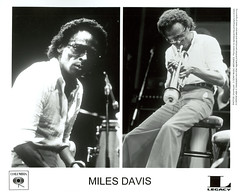Miles Dewey Davis III (May 26, 1926 – September 28, 1991) was an American jazz trumpeter, bandleader, and composer, notes Wikipedia.
Widely considered one of the most influential musicians of the 20th century, Davis was at the forefront of almost every major development in jazz from World War II to the 1990s: he played on various early bebop records and recorded one of the first cool jazz records; he was partially responsible for the development of hard bop and modal jazz, and both jazz-funk and jazz fusion arose from his work with other musicians in the late 1960s and early 1970s; and his final album blended jazz and rap.
Many leading jazz musicians made their names in Davis's groups, including pianist Herbie Hancock, saxophonist John Coltrane, saxophonist Kenny Garrett, and guitarist John McLaughlin.
As a trumpeter, Davis had a pure, round sound but also an unusual freedom of articulation and pitch. He was known for favoring a low register and relatively sparse playing that served the song rather than display flashy playing, but Davis was also capable of highly complex and technically demanding trumpet work.
Kind of Blue is his magnum opus. In March and April 1959, Davis re-entered the studio with his working sextet to record Kind of Blue. He called back Bill Evans for the album sessions as the music had been planned around Evans' piano style.[3] Equally crucially, both Davis and Evans had direct familiarity with the ideas of pianist George Russell regarding modal jazz, Davis from discussions with Russell and others prior to what came to be known as the Birth of the Cool sessions.
Davis convinced Coltrane to play with the group on one final European tour in the spring of 1960. Coltrane then departed to form his classic quartet, although he returned for some of the tracks on the 1961 album Someday My Prince Will Come.
By the end of the summer, Davis had convinced Wayne Shorter to quit Art Blakey's Jazz Messengers. Shorter became the principal composer of Davis' quintet, and some of his compositions of this era ("Footprints", "Nefertiti") are now standards.
By the time of E.S.P. (1965) Davis' lineup consisted of Wayne Shorter, Herbie Hancock, Ron Carter (bass) and Tony Williams (drums). This lineup, the last of his acoustic bands, is often known as "the second great quintet."
Electric Miles" by the time In a Silent Way had been recorded in February 1969, Davis had augmented his standard quintet with additional players. Hancock and Joe Zawinul were brought in to assist Corea on electric keyboards, and guitarist John McLaughlin made the first of his many appearances. By this point, Shorter was also doubling on soprano saxophone. After recording this album, Williams left to form his group Lifetime and was replaced by Jack DeJohnette.
Six months later, an even larger group of musicians, including Jack DeJohnette, Airto Moreira and Bennie Maupin recorded the double LP Bitches Brew, which became a huge seller, hitting gold record status (half a million copies) by 1976. This album and In a Silent Way were among the first fusions of jazz and rock that were commercially successful, building on the groundwork laid by Charles Lloyd, Larry Coryell, and many others who pioneered a genre that would become known simply as "Jazz-rock fusion".
Davis was troubled by osteoarthritis (which led to a hip replacement operation in 1976, the first of several), sickle-cell anemia, depression, bursitis, ulcers and a renewed dependence on alcohol and drugs (primarily cocaine), and his performances were routinely panned throughout late 1974 and early 1975. By the time the group reached Japan in February 1975, Davis was teetering on a physical breakdown and required copious amounts of vodka and narcotics to complete his engagements.
After a Newport Jazz Festival performance at Avery Fisher Hall in New York on July 1, 1975, Davis withdrew almost completely from the public eye for six years. As Gil Evans said, "His organism is tired. And after all the music he's contributed for 35 years, he needs a rest."[citation needed]
Davis characterized this period in his memoirs as a colorful time when wealthy women lavished him with sex and drugs. In reality, he had become completely dependent upon various drugs, spending nearly all of his time propped up on a couch in his apartment watching television, leaving only to score more drugs.
By 1979, Davis had rekindled his relationship with actress Cicely Tyson. With Tyson, Davis would overcome his heroin addiction and regain his enthusiasm for music. As he had not played trumpet for the better part of three years, regaining his famed embouchure proved to be particularly arduous. While recording The Man With The Horn (sessions were spread sporadically over 1979-1981), Davis played mostly wah-wah with a younger, larger band.
Miles Davis died on September 28, 1991 from a stroke, pneumonia and respiratory failure in Santa Monica, California at the age of 65. He is buried in Woodlawn Cemetery in The Bronx, New York.

No comments:
Post a Comment